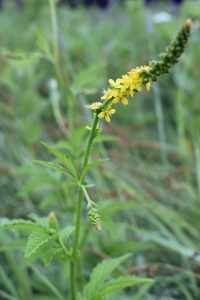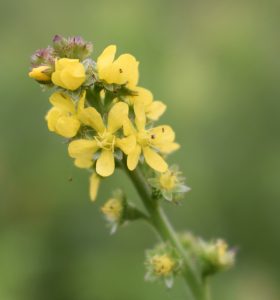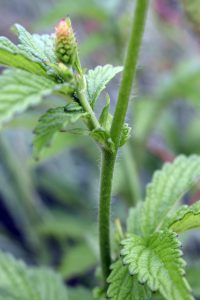Roadside Agrimony (Agrimonia striata)
 Agrimonia striata sends up spike-like racemes bending this way and that for a very pretty effect throughout moist fields, along rivers, woodland edges, shores and swamps in sun or part shade. That said, Agrimony plants don’t require profuse moisture, just enough to keep them happy. The spikes ascend from the top of the stem and also from the upper leaf axils, and are covered with 1/4 inch flowers. This native perennial in the Rose family can grow up to 6 feet tall. (The ones I’ve seen in the field abutting the river are all about 3 feet tall.) They begin blooming just before the milkweeds do, June continuing through September. Flowers are 1/4 to 1/3 inch across. Five green sepals with pointed tips peek between 5 rounded petals, and between 5 to 10 stamens emerge with tips that can range in color from yellow to orange to red.
Agrimonia striata sends up spike-like racemes bending this way and that for a very pretty effect throughout moist fields, along rivers, woodland edges, shores and swamps in sun or part shade. That said, Agrimony plants don’t require profuse moisture, just enough to keep them happy. The spikes ascend from the top of the stem and also from the upper leaf axils, and are covered with 1/4 inch flowers. This native perennial in the Rose family can grow up to 6 feet tall. (The ones I’ve seen in the field abutting the river are all about 3 feet tall.) They begin blooming just before the milkweeds do, June continuing through September. Flowers are 1/4 to 1/3 inch across. Five green sepals with pointed tips peek between 5 rounded petals, and between 5 to 10 stamens emerge with tips that can range in color from yellow to orange to red.

Minnesota has a few Agrimony species. In general, plants in this genus tend to have tiny flowers growing up a single spike, with jagged leaves and spiny fruits. They also all have a persistent calyx-like structure called a hypanthium inside of which a single seed forms. Hikers, hunters, and their dogs will find, come autumn, that the hypanthium is covered on the outside tip with barbed bristles that cling to fur and clothing, thus disseminating the seed.
 Striata species can be distinguished from others in the Agrimonia genus by observing the leaf stipules, which in this case are jagged-toothed along the rounded base leading to a broader, pointed tip (see photo). Leaf stipules are located at or near the base of the stem (petiole).
Striata species can be distinguished from others in the Agrimonia genus by observing the leaf stipules, which in this case are jagged-toothed along the rounded base leading to a broader, pointed tip (see photo). Leaf stipules are located at or near the base of the stem (petiole).
Fun Facts:
- In the language of giving and receiving flowers, a gift of agrimony signifies thankfulness or gratitude.
- The plant is not known as edible, but medicinally all parts of the plant are astringent, traditionally used by knowledgeable herbalists to treat urinary tract conditions among other complaints.
